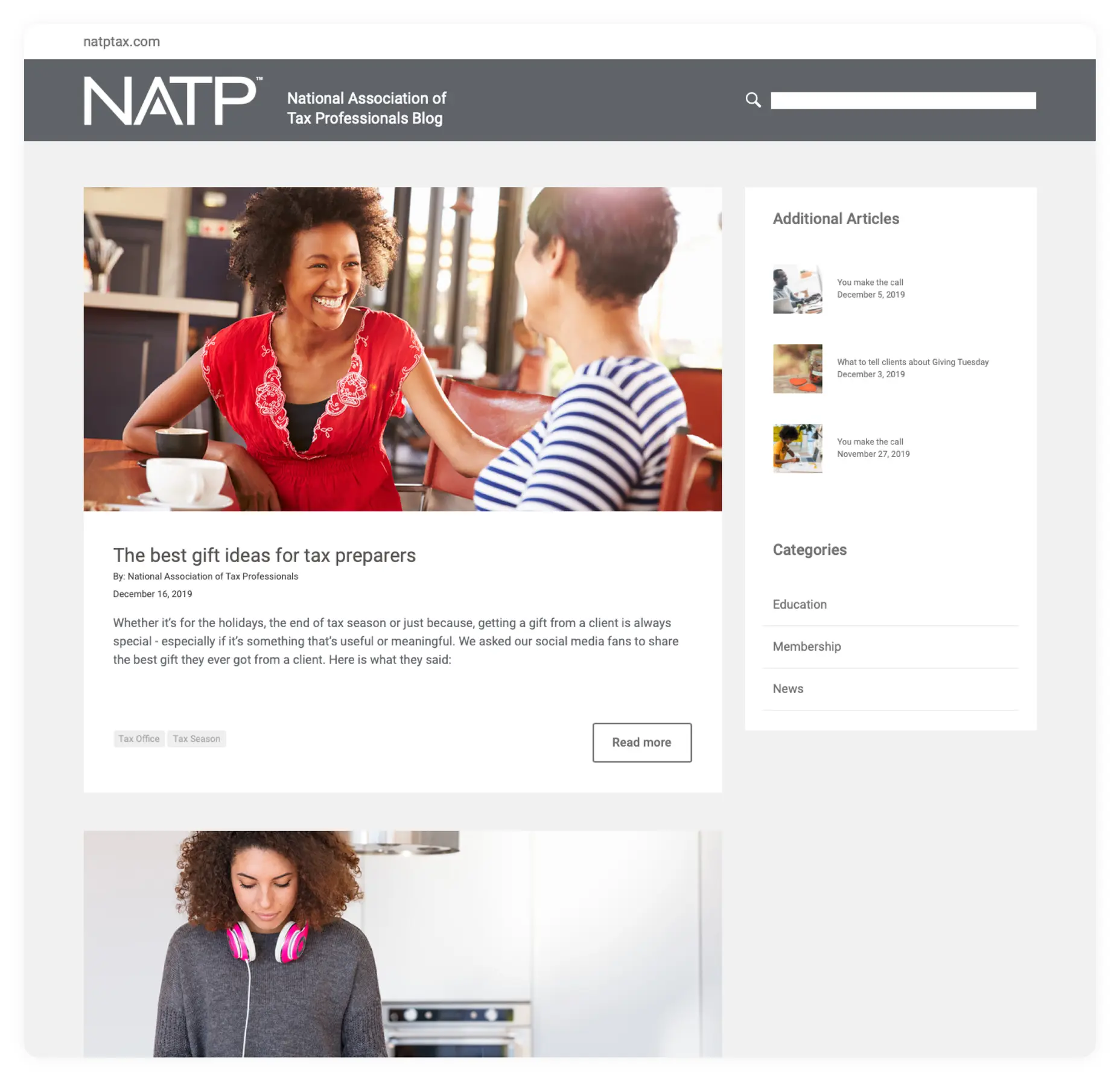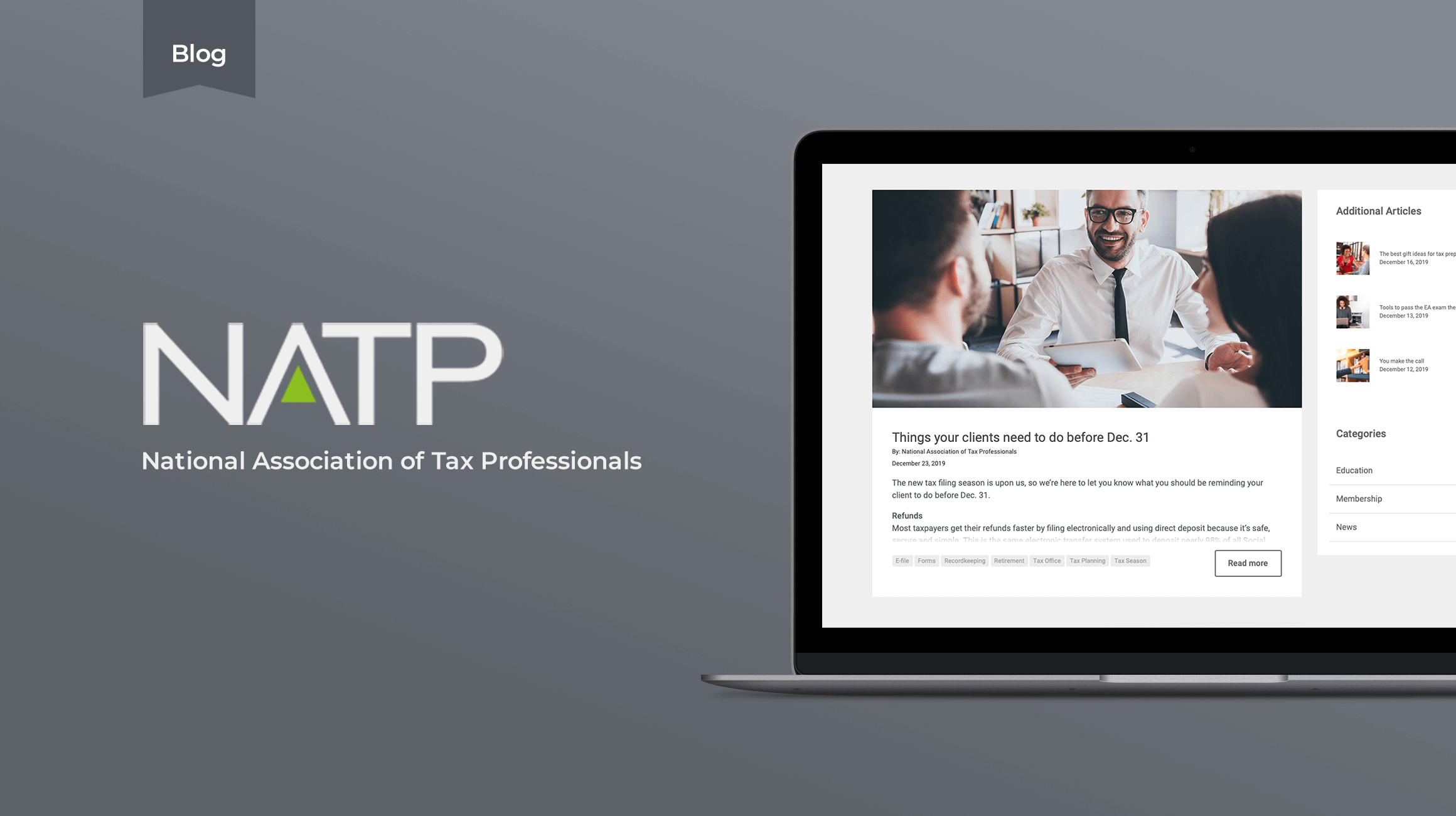- What we do
- Services
- Solutions
- Our Works
- Company
- Contact Us
December 24, 2019
How We Developed A Super Blog for Tax Professionals
It looks like big companies don’t want WordPress blogs anymore. Indeed, why bother with an outdated dashboard and messy plugins? What you really need is a tailor-made content solution with lots of cool features that are available when you want them. Keep reading to discover how we created a unique corporate blog for the NATP, America’s largest nonprofit organization for tax research and education!
Gone is the time for WordPress blogs. These days, companies and organizations are looking for tailor-made CMS solutions to manage their dynamic content. In fact, having a unique content infrastructure not only saves time for developers and editors, it also helps improve Google ranking.
Meet our new project – the blog of the National Association of Tax Professionals, one of the leading portals for US tax matters. Our team has gradually expanded the blog’s functionality and structure. So far, we have improved the blog’s social media sharing capacities and added a number of features, such as advanced search options, clickable tags, RSS, and a mobile version. Moreover, we plan to create a forum for the blog, author profiles, and user profiles with ratings.
Our Client
Paying taxes in the United States can be a daunting process, especially for the inexperienced. This has given rise to a number of organizations providing tax advocacy and service. The National Association of Tax Professionals (NATP) is the largest nonprofit delivering tax education and federal tax research. It comprises more than 23,000 tax professionals who provide content expertise and information support on a regular basis.
NATP members work at offices across the United States, assisting over 11 million people with tax planning. NATP’s staff includes professional tax agents, certified accountants, lawyers, and financial planners, each with unique expertise attained while resolving real-world tax cases. To share their contributions and tax information updates, NATP required a sophisticated corporate blog.

Project Goal
As blog developers, our main goal was to create a corporate blog with unique content-adding features that were sophisticated, yet simple to use for both editors and readers. Apart from that, we faced a number of challenging tasks:
- To create an excellent content infrastructure coupled with a user-friendly dashboard for editors
- To optimize blog post searching
- To improve the blog’s social media integration and sharing
- To accelerate page loading
- To increase the blog’s Google ranking
- To enhance SEO
Work
High-level content infrastructure
First, we created a high-level content infrastructure for editing and managing blog posts. Together with the client, we decided to use the Contentful API-First content management infrastructure to supervise content addition and distribution. The major benefit of Contentful is that it stores content in a single hub, allowing editors and developers to work simultaneously.
Social media sharing
Second, we created accelerated pages for mobile devices and improved social media integration and sharing. We optimized the social media sharing buttons and the way content is displayed in social media posts. Now users can share blog articles via Facebook, Twitter, and LinkedIn. They can also send an article via email and read the blog’s RSS. When users share links to the blog’s posts via social media, there is a text preview with titles and pictures.
Sitemap
Third, we created a sitemap. We made sure that headings, subheadings, bullet lists, number lists, and bold text are all displayed correctly. In the future, this improved markdown will definitely improve how Google renders content from the blog.
Searching for blog posts
Fourth, we optimized searching for blog posts. In the beginning, users could only search for posts by title. However, we added new options for searching by clickable tags and by categories. Also, we created a new feature that shows “About” information after every blog post.
Improved SEO
Finally, we have made progress towards improved SEO, creating an RSS feed for the blog, and building a mobile version of it.

Results
Though we continue to work on the project, there is a number of achievements we are happy to share:
The blog is much faster
We have accomplished a tremendous boost in speed through optimized image loading. Now the blog’s pictures are loaded only when they will be fully visible. Previously, all the blog’s numerous pictures (up to 100) loaded simultaneously, slowing down the loading speed.
New content models
We have created interconnected content models: articles, authors, categories, and tags. This improves interlinking between blog posts, thereby improving the website’s rendering by Google.
Lots of cool features
We would particularly like to stress the following: clickable tags, advanced search options (by titles, by tags, and by categories), advanced content preview in social media, “About” block after every article, RSS, and a mobile version.
Project Duration
Actual work on the project took over a week to complete. However, we thoroughly discussed each added feature with NATP, bringing the total project duration to more than two months.
Team
- Project manager
- Tech lead
- Developer
Technologies
- Next.js
- NodeJS
- Docker
- Contentful
- AWS
- Redux
- Redux-Saga
- Open Graph
- AMP (Accelerated mobile pages)
- RSS
- XML
Challenges and Solutions
While working on the project, we faced a number of challenges. Here are the solutions we would like to share:
Content infrastructure
We selected AWS cloud infrastructure and Contentful API-First CMS to store and edit content in a single hub. Now content editors and blog developers are able to work simultaneously on content publishing and the blog’s features.
Advanced search options
In the beginning, users could only search for posts by title. We have extended search options by adding clickable tags and categories.
Sitemap + RSS
To generate a sitemap and feed for RSS, we decided to use the XML language, in particular, the package “XML Builder.”

Conclusion
As WordPress fails to meet the expectations of demanding clients, more companies and organizations are looking for unique CMS solutions for their blogs. Indeed, tailor-made content infrastructure provides tremendous flexibility in terms of adding new features and improving Google rendering.
At Yellow, we received an amazing opportunity to create a sophisticated corporate blog for the National Association of Tax Professionals. So far we have created the content infrastructure for the blog, improved Google rendering and markdown features, optimized options for article searches, added clickable tags, and accelerated the website.
In the future, we plan to develop additional features for the blog, including a forum, a comments section, author profiles, and user profiles with rankings. Our final goal is to establish the NATP blog as the top source for US taxpayer information.
Got a project in mind?
Fill in this form or send us an e-mail
Subscribe to new posts.
Get weekly updates on the newest design stories, case studies and tips right in your mailbox.
